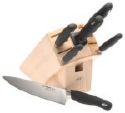The first knives were most likely made of wood, bone and other perishable materials. These ancient tools were shaped by knapping, or percussive flaking of rock, such as obsidian and flint.
As advances in metallurgy were made, materials such as wood, stone, and bone blades were gradually succeeded by copper, bronze, iron, and eventually steel. During the Middle Ages, knives joined the fork and spoon as the prominent pieces of cutlery in the western world. As a result, much of the world’s population was exposed to knives as a daily utensil and tool.
Today’s knives come in many shapes and sizes but can be categorized between two types: fixed blade knives and folding, or pocket, knives. Blades may be serrated or plain, or even a combination of both. Some knives contain a tang, a portion of blade that extends into the handle.
Fixed Blade Knives
Unlike its earlier predecessors, blades of today can be manufactured from a variety of materials, each with its advantages and disadvantages. An alloy of carbon and iron, carbon steel is very sharp and is easy to sharpen, but is susceptible to rust and stains. An alloy of iron, chromium, nickel, and molybdenum, stainless steel is not able to take on quite as sharp an edge as carbon steel, but it is highly resistant to corrosion. Intended to combine the best attributes of carbon steel and stainless steel, high carbon stainless steel blades are able to maintain a sharp edge and do not discolor or stain.
Laminate blades are created by a layer of harder, more brittle steel that is sandwiched between an outer layer of softer, tougher stainless steel to reduce chances of corrosion. Pattern-welding is another technique similar to laminate construction, which welds various steel types in layers, but then the stock is manipulated to create patterns in the steel. A lighter, more wear resistant metal, titanium is more flexible than steel, although it is unable to take as sharp an edge. However, carbides in the titanium alloy allow them to be heat-treated to a sufficient hardness. Largely immune to corrosion, ceramic blades are very hard and lightweight blades, able to maintain a sharp edge for years at a time with little or no maintenance. Ceramic blades may only be sharpened on silicon carbide sandpaper and some grinding wheels.
Forging & Stock Removal
Steel blades are commonly shaped by forging or stock removal. Blades are forged by heating a single piece of steel and shaping the metal while it is hot with a hammer or press. Stock removal blades are shaped by grinding the removing metal. After shaping with both methods, the blade must be heat treated, which involves heating the steel above its critical point and then quenching the blade to harden it. Once the blade is hardened, it is tempered to remove stresses and toughen the blade. Forging tends to be used for more high-end product cutlery lines.
Folding Knives
Connected to the handle through a pivot, the folding knife’s blade is able to fold into the handle. Folding knives are typically created with a locking mechanism to prevent the blade from accidentally closing on the user’s hand.
Found most commonly on traditional pocket knives, a slip joint holds the open blade in place by a spring device that allows the blade to fold if a certain amount of pressure is applied. A lockback includes a pivoted latch connected to a spring, and can be disengaged only by pressing the latch down to release the blade. Other types of popular locking features include: liner lock, frame lock, button lock, and axis lock.
Life of the Knife
Throughout history, knives have served various purposes – from cutlery to weaponry. Here are a few of its uses:
Knives as Weapons
Bayonet Knife – a knife-shaped fighting weapon attached to the muzzle of a rifle or similar weapon.
Combat Knife – any knife mainly intended for fighting
Trench Knife – Purpose-made or improvised knife intended for close-quarter fighting, particularly in trench warfare.
Shiv – prevalent in prisons, this knife is a crudely homemade weapon out of everyday materials
Switchblade – A knife with a folding blade that springs out of the grip when a button or lever on the grip is pressed
Knives as Tools
Electrician’s Knife – An insulated knife used to cut electrical wire
Diver’s Knife – A standard part of diving dress, the diver’s knife has been adapted for use in diving and water sports
Hunting Knife – Used to dress large game
Pocket Knife – Also known as a multi-tool, the pocket knife contains several blades, as well as other tools
Utility Knife – Used for cutting sheet materials, including moving boxes, cardboard boxes and shipping and receiving containers.

